GOLDEN ORCHIDS STORE.
On this page, you find all documents, package deals, and flashcards offered by seller Emillect.
- 2872
- 0
- 65
Community
- Followers
- Following
2937 items
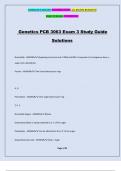
Genetics PCB 3063 Exam 3 Study Guide Solutions
Genetics PCB 3063 Exam 3 Study Guide Solutions Nucleotide - ANSWER-Repeating structural unit of DNA and RNA. Composed of a nitrogenous base, a sugar, and a phosphate. Purines - ANSWER-Two fused heterocyclic rings A, G Pyrimidines - ANSWER-One single heterocyclic ring T, U, C Nucleotide Sugars - ANSWER-Ribose Deoxyribose (Base is always attached to C-1' of the sugar. Phosphates - ANSWER-Can be attached to the C-5' of the sugar. Deoxyribonucleo-side - ANSWER-Base + Sugar ©EMILLE...
- Exam (elaborations)
- • 18 pages •
Genetics PCB 3063 Exam 3 Study Guide Solutions Nucleotide - ANSWER-Repeating structural unit of DNA and RNA. Composed of a nitrogenous base, a sugar, and a phosphate. Purines - ANSWER-Two fused heterocyclic rings A, G Pyrimidines - ANSWER-One single heterocyclic ring T, U, C Nucleotide Sugars - ANSWER-Ribose Deoxyribose (Base is always attached to C-1' of the sugar. Phosphates - ANSWER-Can be attached to the C-5' of the sugar. Deoxyribonucleo-side - ANSWER-Base + Sugar ©EMILLE...
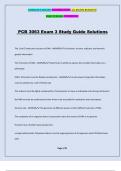
PCB 3063 Exam 3 Study Guide Solutions
PCB 3063 Exam 3 Study Guide Solutions The 1˚and 2˚molecular structure of DNA - ANSWER-Its function: to store, replicate, and transmit genetic information The 3˚structure of DNA - ANSWER-Determines its ability to express the encoded information as a phenotype DNA's 3˚structure must be flexible and dynamic - ANSWER-A vast amount of genetic information must be packed into a cell of limited size This material must be tightly condensed for chromosomes to move as individual units during ...
- Exam (elaborations)
- • 76 pages •
PCB 3063 Exam 3 Study Guide Solutions The 1˚and 2˚molecular structure of DNA - ANSWER-Its function: to store, replicate, and transmit genetic information The 3˚structure of DNA - ANSWER-Determines its ability to express the encoded information as a phenotype DNA's 3˚structure must be flexible and dynamic - ANSWER-A vast amount of genetic information must be packed into a cell of limited size This material must be tightly condensed for chromosomes to move as individual units during ...

PCB 3063 EXAM 1 STUDY GUIDE SOLUTIONS
PCB 3063 EXAM 1 STUDY GUIDE SOLUTIONS genome - ANSWER-complete set of genetic instructions for any organism; encoded in nucleic acid transmission genetics - ANSWER-encompasses the basic principles of heredity and how traits are passed from one generation to the next molecular genetics - ANSWER-concerns the chemical nature of the gene itself: how genetic information is encoded, replicated and expressed population genetics - ANSWER-explores the genetic composition of groups and individuals o...
- Exam (elaborations)
- • 16 pages •
PCB 3063 EXAM 1 STUDY GUIDE SOLUTIONS genome - ANSWER-complete set of genetic instructions for any organism; encoded in nucleic acid transmission genetics - ANSWER-encompasses the basic principles of heredity and how traits are passed from one generation to the next molecular genetics - ANSWER-concerns the chemical nature of the gene itself: how genetic information is encoded, replicated and expressed population genetics - ANSWER-explores the genetic composition of groups and individuals o...

PCB 3063 Exam 1 Questions and Answers
PCB 3063 Exam 1 Questions and Answers 1970s - ANSWER-DNA cloning tech tools to understand human genome genomics - ANSWER-sequencing human genome bioinformatics - ANSWER-molecular biology and computer science What are the similarities between human and bacterial DNA? - ANSWER-double stranded, universal genetic code Francis Crick - ANSWER-central dogma, DNA - RNA - protein model organisms - ANSWER-short generations, large progeny, adapt to lab, inexpensiveness to maintain 1953 - ANSWER-Wa...
- Exam (elaborations)
- • 12 pages •
PCB 3063 Exam 1 Questions and Answers 1970s - ANSWER-DNA cloning tech tools to understand human genome genomics - ANSWER-sequencing human genome bioinformatics - ANSWER-molecular biology and computer science What are the similarities between human and bacterial DNA? - ANSWER-double stranded, universal genetic code Francis Crick - ANSWER-central dogma, DNA - RNA - protein model organisms - ANSWER-short generations, large progeny, adapt to lab, inexpensiveness to maintain 1953 - ANSWER-Wa...
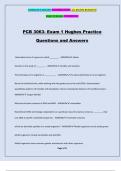
PCB 3063- Exam 1 Hughes Practice Questions and Answers
PCB 3063- Exam 1 Hughes Practice Questions and Answers Alternative forms of a gene are called ________. - ANSWER-alleles Genetics is the study of ________. - ANSWER-heredity and variation The phenotype of an organism is __________. - ANSWER-the observable features of an organism Name the individual who, while working with the garden pea in the mid-1850s, demonstrated quantitative patterns of heredity and developed a theory involving the behavior of hereditary factors. - ANSWER-Gregor Mend...
- Exam (elaborations)
- • 11 pages •
PCB 3063- Exam 1 Hughes Practice Questions and Answers Alternative forms of a gene are called ________. - ANSWER-alleles Genetics is the study of ________. - ANSWER-heredity and variation The phenotype of an organism is __________. - ANSWER-the observable features of an organism Name the individual who, while working with the garden pea in the mid-1850s, demonstrated quantitative patterns of heredity and developed a theory involving the behavior of hereditary factors. - ANSWER-Gregor Mend...
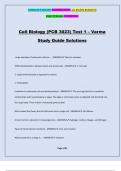
Cell Biology (PCB 3023) Test 1 – Varma Study Guide Solutions
Cell Biology (PCB 3023) Test 1 – Varma Study Guide Solutions Large examples of eukaryotic cells are... - ANSWER-Yeast or amoebas Differentiating factors between plant and animal cells - ANSWER-1. Cell wall 2. Large central vacuole as opposed to vesicles 2. Chloroplasts Limitation to eukaryotic cells and photosynthesis - ANSWER-The sea slugs that live in symbiotic relationships with cyanobacteria or algae. The algae is not broken down or digested and absorbed into the slug's body. Th...
- Exam (elaborations)
- • 26 pages •
Cell Biology (PCB 3023) Test 1 – Varma Study Guide Solutions Large examples of eukaryotic cells are... - ANSWER-Yeast or amoebas Differentiating factors between plant and animal cells - ANSWER-1. Cell wall 2. Large central vacuole as opposed to vesicles 2. Chloroplasts Limitation to eukaryotic cells and photosynthesis - ANSWER-The sea slugs that live in symbiotic relationships with cyanobacteria or algae. The algae is not broken down or digested and absorbed into the slug's body. Th...

PCB 3023 Exam 1 Study Guide Solutions
PCB 3023 Exam 1 Study Guide Solutions Flow of genetic information in all living cells - ANSWER-DNA -> RNA -> Protein Replication-> Transcription -> Translation Miller-Urey experiment - ANSWER-recreated conditions thought to exist in the atmosphere of primitive earth. No Oxygen! Used heat to simulate sun, electric discharge to simulate lightning, and cooling to condense molecules to liquid form. 7 simple molecules: water vapor, nitrogen, ammonia, co2, co, methane, and hydrogen....
- Exam (elaborations)
- • 18 pages •
PCB 3023 Exam 1 Study Guide Solutions Flow of genetic information in all living cells - ANSWER-DNA -> RNA -> Protein Replication-> Transcription -> Translation Miller-Urey experiment - ANSWER-recreated conditions thought to exist in the atmosphere of primitive earth. No Oxygen! Used heat to simulate sun, electric discharge to simulate lightning, and cooling to condense molecules to liquid form. 7 simple molecules: water vapor, nitrogen, ammonia, co2, co, methane, and hydrogen....
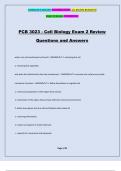
PCB 3023 - Cell Biology Exam 2 Review Questions and Answers
PCB 3023 - Cell Biology Exam 2 Review Questions and Answers where can cell membranes be found? - ANSWER-1. enclosing the cell 2. enclosing the organalles why does the mitochondria has two membranes? - ANSWER-to increase the surface area inside membrane functions - ANSWER-1. define boundaries to regulate the a. chemical composition of the region they enclose b. interaction of the region they enclose with their external environment 2. define boundaries that are soft and flexible which allo...
- Exam (elaborations)
- • 18 pages •
PCB 3023 - Cell Biology Exam 2 Review Questions and Answers where can cell membranes be found? - ANSWER-1. enclosing the cell 2. enclosing the organalles why does the mitochondria has two membranes? - ANSWER-to increase the surface area inside membrane functions - ANSWER-1. define boundaries to regulate the a. chemical composition of the region they enclose b. interaction of the region they enclose with their external environment 2. define boundaries that are soft and flexible which allo...

PCB 3023 : Cell Biology Final Review Study Guide Solutions
PCB 3023 : Cell Biology Final Review Study Guide Solutions If PAGE is carried out after subjecting the sample to SDS and beta-mercaptoethanol, then proteins will be separated on the basis of - ANSWER-Mass Which is the most abundant molecule in a bacterial cell? - ANSWER-Water Which of the following is true about the molecular properties of water? A) Water has a dipole moment. B) Water can form hydrogen bonds with other water molecules. C) Water can form hydrogen bonds with proteins, nucle...
- Exam (elaborations)
- • 31 pages •
PCB 3023 : Cell Biology Final Review Study Guide Solutions If PAGE is carried out after subjecting the sample to SDS and beta-mercaptoethanol, then proteins will be separated on the basis of - ANSWER-Mass Which is the most abundant molecule in a bacterial cell? - ANSWER-Water Which of the following is true about the molecular properties of water? A) Water has a dipole moment. B) Water can form hydrogen bonds with other water molecules. C) Water can form hydrogen bonds with proteins, nucle...
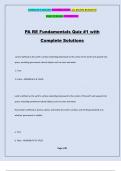
PA RE Fundamentals Quiz #1 with Complete Solutions
PA RE Fundamentals Quiz #1 with Complete Solutions Land is defined as the earth's surface extending downward to the center of the earth and upward into space, excluding permanent natural objects such as trees and water. a. True b. False - ANSWER-B. FALSE Land is defined as the earth's surface extending downward to the center of the earth and upward into space, including permanent natural objects such as trees and water. Real estate is defined as land at, above, and below the earth...
- Exam (elaborations)
- • 30 pages •
PA RE Fundamentals Quiz #1 with Complete Solutions Land is defined as the earth's surface extending downward to the center of the earth and upward into space, excluding permanent natural objects such as trees and water. a. True b. False - ANSWER-B. FALSE Land is defined as the earth's surface extending downward to the center of the earth and upward into space, including permanent natural objects such as trees and water. Real estate is defined as land at, above, and below the earth...
